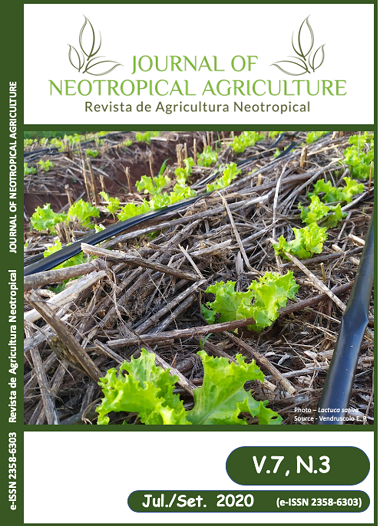YIELD OF IRRIGATED CABBAGE SUBMITTED TO DIFFERENT SOURCES AND DOSES OF BORON
DOI:
https://doi.org/10.32404/rean.v7i3.4166Abstract
Cabbage is an important vegetable for food. The use of micronutrients, more specifically boron, is important for plant development and head formation. The study aimed to evaluate the agronomic performance and yield of the cabbage crop submitted to the application of different sources and doses of boron. The study was carried out in the Água Verde farm, located in Nova Glória-GO, under irrigation by a center pivot system. The soil tillage consisted of operation with a subsoiler and a disk harrow. The fertilization was carried out by applying 48 kg ha-1 of N, 360 kg ha-1 of P2O5, and 120 kg ha-1 of K2O, in the planting furrow. The seedling transplant took place on 06/22/2019. At 20 days after transplanting, topdressing fertilization was carried out, with 200 kg ha-1 of N and 200 ha-1 of K2O. A randomized block design with four replications in a 4x5 factorial scheme was used. Four boron sources (boric acid, borax, ulexite, and Sulforgan) and five boron doses (0.0, 0.5, 1.0, 2.0, and 3.0 kg ha-1) were evaluated. Each experimental plot consisted of four rows of five meters in length. The evaluations were carried out on the two central rows, with 0.50 m at each end. The variables analyzed were plant height, longitudinal diameter, transverse diameter, number of outer leaves, and yield (kg ha-1). There was no significant difference between the different boron sources evaluated. For the different boron doses applied, only the number of outer leaves did not obtain a significant regression. The application of boron at a dose of 1.8 kg ha-1 resulted in the highest cabbage-head yield, totaling 82.58 t ha-1.
References
(I) Bergamin, L.G., Cruz, M.C.P., Ferreira, M.E., Barbosa, J.C., 2005. Produção de repolho em função da aplicação de boro associada à adubo orgânico. Horticultura Brasileira, 23(2), 311-315.
(II) Cassol, S.P., Lenhardt, E.R., Gabriel, V.J., 2017. Caracterização dos estádios fenológicos e a exigência de adubação do repolho. Ciências agroveterinárias e alimentos, 2, 1-12.
(III) FAOSTAT, 2017. Countries by commodity. http://www.fao.org/faostat/en/#rankings/countries_by_commodity (acessado 19 de setembro de 2019).
(IV) Filgueira, F.A.R., 2012. Novo manual de olericultura: agrotecnologia moderna na produção e comercialização de hortaliças, terceira ed. Viçosa, UFV.
(V) Filgueira, F.A.R., 2013. Novo manual de olericultura: agrotecnologia moderna na produção e comercialização de hortaliças, terceira ed. rev. ampl. Viçosa, UFV.
(VI) IBGE, 2017. Horticultura (Número de estabelecimentos agropecuários e Quantidade produzida, por produtos da horticultura. 2017). https://sidra.ibge.gov.br/tabela/6619 (acessado 10 de julho de 2019).
(VII) INMET. Instituto Nacional de Meteorologia, 2019. http://www.inmet.gov.br/portal/index.php?r=home/page&page=rede_estacoes_auto_graf (acessado 02 de dezembro de 2019).
(VIII) Luz, F.J.F., Saboya, R.C.C., Pereira, P.R.V.S., 2002. O cultivo do repolho em Roraima. Boa Vista, Embrapa Roraima, 17 p. (Circular técnica, 7).
(IX) Malavolta, E., 2006. Manual de nutrição mineral de plantas. São Paulo, Agronômica Ceres.
(X) Malavolta, E., Vitti, C.G., Oliveira, S.A., 1997. Avaliação do estudo nutricional das plantas: princípios e aplicações. Piracicaba, Potafós.
(XI) Marouelli, A.W., Melo, R.A.C., Braga, M.B., 2017. Irrigação no cultivo de brássicas. Embrapa Hortaliças, Brasília, 25 p. (Circular técnica, 158).
(XII) Moreira, M.A., Vidigal, S.M., Sediyama, M.A.N., Santos, M.R., 2011. Crescimento e produção de repolho em função de doses de nitrogênio. Horticultura Brasileira, 29(1), 117-121.
(XIII) Perin, A., Cruvinel, D.A., Ferreira, H.S., Melo, G.B., Lima, L.E., Andrade, J.W.S., 2015. Decomposição da Palhada e Produção de Repolho em Sistema Plantio Direto. Global Science and Technology, 8(2), 153-159.
(XIV) Pizetta, L.C., Ferreira, M.E., Cruz, M.C.P., Barbosa, J.C., 2005. Resposta de brócolis, couve-flor e repolho à adubação com boro em solo arenoso. Horticultura Brasileira, 23(1), 51-56.
(XV) Reis, M.R., Melo, C.A.D., Raposo, T.P., Aquino, R.F.B.A., Aaquino, L.A., 2017. Selectivity of herbicides to cabbage (Brassica oleracea var. capitata). Planta Daninha, 35(1), 1-6.
(XVI) Ruiz Junior, E.C., Gonçalves, F.M., Michelan, K.S., Hora, R.C., 2012. Avaliação fitotécnica de plantas de repolho roxo cultivadas sob diferentes densidades e fontes de nitrogênio. Cultivando o saber, 5(4), 124-132.
(XVII) Silva, K.S., Santos, E.C.M., Benett, C.G.S., Laranjeira, L.T., Eberhardt Neto, E., Costa, E., 2012. Produtividade e desenvolvimento de cultivares de repolho em função de doses de boro. Horticultura Brasileira, 30(3) 520-525.
(XVIII) Silva, L.M., Basílio, S.A., Silva Júnior, R.L., Nascimento, M.V., Benett, C.G.S., Benett, K.S.S., 2014. Aplicação de ácido bórico sobre as características produtivas do repolho em diferentes épocas. Revista de Agricultura Neotropical, 1(2), 26-34.
(XIX) Taiz, L., Zeiger, E., 2013. Fisiologia vegetal, quinta ed. Porto Alegre, Artemed.
(XX) Trani, P.E., Passos, F.A., Azevedo, J.A., Tavares, M., 1996. Brócolos, couve-flor e repolho, in: Raij, B.V., Cantarella, H., Quaggio, J.A., Furlani, A.M.C., (Ed.). Recomendações de adubação e calagem para o Estado de São Paulo. Campinas-SP: Instituto Agronômico/Fundação IAC, 285 p. (Boletim técnico, 100).
Downloads
Published
How to Cite
Issue
Section
License
The authors retain the rights to the manuscripts and, therefore, are free to share, copy, distribute, perform and publicly communicate the work under the following conditions:
Acknowledge work credits in the manner specified by the author or licensor (but not in a way that suggests that you have their support or that they support their use of their work).
REVISTA DE AGRICULTURA NEOTROPICAL (ISSN 2358-6303) is under license https://creativecommons.org/licenses/by/4.0/
The State University of Mato Grosso do Sul, Sustainable Development Center of Bolsão Sul-Mato-grossense (CEDESU), of the University Unit of Cassilândia (UUC), preserves the patrimonial rights (copyright) of the published works and favors and allows their reuse under the license as mentioned above.
------------
The journal reserves the right to make normative, orthographic, and grammatical alterations in the originals, to maintain the cult standard of the language, respecting, however, the style of the authors.
Final proofs will be sent to the authors.
Published works become the property of the journal. The opinions expressed by the authors of the manuscripts are their sole responsibility.

